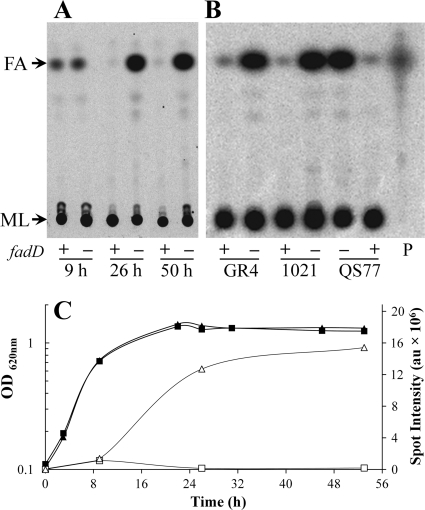Fig. 1.
S. meliloti fadD mutants accumulate fatty acids in the stationary phase of growth. (A) Cellular lipid extracts obtained either from wild-type S. meliloti GR4 (fadD+) or from its fadD-deficient mutant QS77 were grown until exponential phase (OD620, 0.7; 9 h of growth), until early stationary phase (OD620, 1.2; 26 h of growth), or until late stationary phase (50 h of growth). (B) Lipid extracts of cultures grown until the early stationary phase (OD620, 1.2) of the S. meliloti strains GR4 (fadD+) and its fadD-deficient mutant derivative QS77; 1021 (fadD+) and its mutant fadD-deficient derivative 1021FDC5; QS77 carrying the empty vector pBBR1MCS-3 or carrying fadD-containing plasmid pBBRD4 (fadD+). P, [14C]palmitic acid. Membrane lipids (ML) did not migrate from the origin, and the spot for fatty acids (FA) is indicated. (C) Growth curves of strains GR4 (■) and QS77 (▴) and quantification of their fatty acids (GR4 [□] and QS77 [▵]), corresponding with the TLC plate shown in panel A. Quantification of the intensity of the spot for fatty acids is given in arbitrary units (au). Cultures were grown on Sherwood minimal medium. Similar results were obtained with cultures grown on Robertsen minimal medium.

